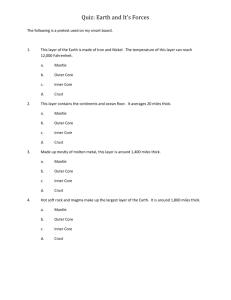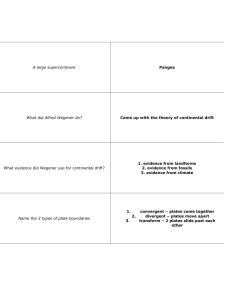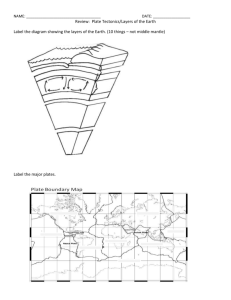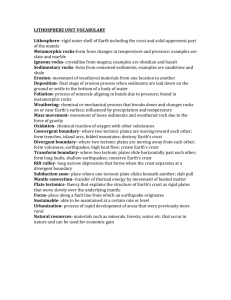earth-test
advertisement
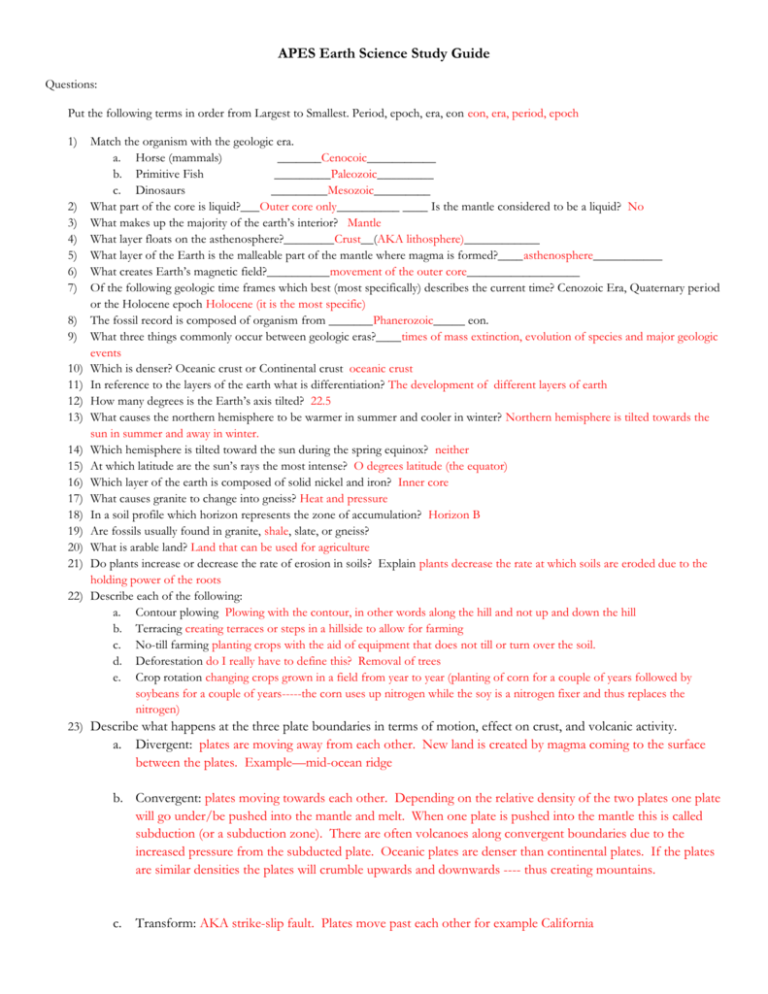
APES Earth Science Study Guide Questions: Put the following terms in order from Largest to Smallest. Period, epoch, era, eon eon, era, period, epoch 1) 2) 3) 4) 5) 6) 7) 8) 9) 10) 11) 12) 13) 14) 15) 16) 17) 18) 19) 20) 21) 22) Match the organism with the geologic era. a. Horse (mammals) _______Cenocoic___________ b. Primitive Fish _________Paleozoic_________ c. Dinosaurs _________Mesozoic_________ What part of the core is liquid?___Outer core only__________ ____ Is the mantle considered to be a liquid? No What makes up the majority of the earth’s interior? Mantle What layer floats on the asthenosphere?________Crust__(AKA lithosphere)____________ What layer of the Earth is the malleable part of the mantle where magma is formed?____asthenosphere___________ What creates Earth’s magnetic field?__________movement of the outer core__________________ Of the following geologic time frames which best (most specifically) describes the current time? Cenozoic Era, Quaternary period or the Holocene epoch Holocene (it is the most specific) The fossil record is composed of organism from _______Phanerozoic_____ eon. What three things commonly occur between geologic eras?____times of mass extinction, evolution of species and major geologic events Which is denser? Oceanic crust or Continental crust oceanic crust In reference to the layers of the earth what is differentiation? The development of different layers of earth How many degrees is the Earth’s axis tilted? 22.5 What causes the northern hemisphere to be warmer in summer and cooler in winter? Northern hemisphere is tilted towards the sun in summer and away in winter. Which hemisphere is tilted toward the sun during the spring equinox? neither At which latitude are the sun’s rays the most intense? O degrees latitude (the equator) Which layer of the earth is composed of solid nickel and iron? Inner core What causes granite to change into gneiss? Heat and pressure In a soil profile which horizon represents the zone of accumulation? Horizon B Are fossils usually found in granite, shale, slate, or gneiss? What is arable land? Land that can be used for agriculture Do plants increase or decrease the rate of erosion in soils? Explain plants decrease the rate at which soils are eroded due to the holding power of the roots Describe each of the following: a. Contour plowing Plowing with the contour, in other words along the hill and not up and down the hill b. Terracing creating terraces or steps in a hillside to allow for farming c. No-till farming planting crops with the aid of equipment that does not till or turn over the soil. d. Deforestation do I really have to define this? Removal of trees e. Crop rotation changing crops grown in a field from year to year (planting of corn for a couple of years followed by soybeans for a couple of years-----the corn uses up nitrogen while the soy is a nitrogen fixer and thus replaces the nitrogen) 23) Describe what happens at the three plate boundaries in terms of motion, effect on crust, and volcanic activity. a. Divergent: plates are moving away from each other. New land is created by magma coming to the surface between the plates. Example—mid-ocean ridge b. Convergent: plates moving towards each other. Depending on the relative density of the two plates one plate will go under/be pushed into the mantle and melt. When one plate is pushed into the mantle this is called subduction (or a subduction zone). There are often volcanoes along convergent boundaries due to the increased pressure from the subducted plate. Oceanic plates are denser than continental plates. If the plates are similar densities the plates will crumble upwards and downwards ---- thus creating mountains. c. Transform: AKA strike-slip fault. Plates move past each other for example California 24) Match the boundary or boundaries with the correct characteristic: d. Creates crust e. Destroys crust f. Associated with volcanoes g. Associated with earthquakes h. Subduction occurs in the ocean resulting in a trench i. Creates mountains _____divergent _______ _________convergent/subduction___ ____________ convergent/subduction __ convergent/subduction ________ __________ convergent/subduction ____________convergent____ 25) State whether the statement is true of false. If false, correct the underlined word to create a true statement. j. __T__ The San Andreas Fault is formed by transform boundaries that create many earthquakes. k. __F__The Andes Mountains is at a convergent boundary. l. __F__ The Himalayan Mountains are increasing as a result of two continental plates colliding. m. __T__ The Mid-Atlantic Ridge is at a divergent plate boundary. 26) Using the terms in the reading, define earthquake. A sudden movement of the earth's crust caused by the release of stress accumulated along geologic faults or by volcanic activity. Also called seism, temblor. 27) Which type of crust is older and composed of granite (calcium, sodium potassium, and aluminum? Continental 28) T/F the Atlantic is getting bigger and so is the Pacific. False, the Atlantic is getting bigger and the Pacific is getting smaller 29) What can magnify the impacts of an earthquake? The underlying strata (the rock/soil type) 30) What are the two causes of tsunamis? Earthquakes and volcanic eruptions 31) Describe how dinosaurs went extinct. Massive volcanic eruptions that blocked the sun and caused an ice-age 32) When a volcanoes erupts, what spews out the top? Ash, dust, sulfur and lava 33) What factors influence the formation of soil? Time, parent material, climate, slope 34) Can volcanic eruptions create new and fertile soils? Can they ……. Release sulfur, block sunlight, create acid rain, or trigger tsunamis? yes 35) Describe each of the soil horizons. (Which layers make up topsoil? O and A 36) Redraw the rock cycle\ 37) Does an earthquakes proximity to a plate boundary magnify the impact? no 38) Match the rock with the statement: a. When rocks melt into magma then cool and harden igneous b. What forms when rocks undergo heat and pressure metamorphic c. This rock forms when rocks are weathered into sediment and then compacted sedimentary d. Categorized by texture and composition igneous e. Forms when rock is heated not melted metamorphic 39) Rock concepts T/F. If false, correct the underlined words f. Heat and pressure changes granite (igneous) into gneiss (metamorphic). true g. Lava/magma is formed when rocks melt. magma
